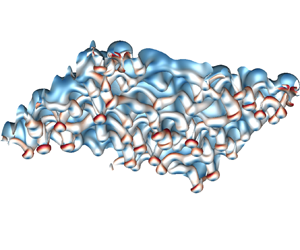Article contents
Effects of the secondary baroclinic vorticity on the energy cascade in the Richtmyer–Meshkov instability
Published online by Cambridge University Press: 31 August 2021
Abstract

We investigate the effect of the secondary baroclinic vorticity (SBV) on the energy cascade in the mixing induced by the multi-mode Richtmyer–Meshkov instability (RMI). With the aid of vorticity-based simplified models and the vortex-surface field, we find that the effect of the SBV peaks at a critical time when the vortex reconnection widely occurs in the mixing zone. Before the critical time, spikes and bubbles evolve almost independently, and we demonstrate that the variation of the kinetic energy spectrum induced by the SBV has the  $-1$ scaling law at intermediate wavenumbers using the model of vortex rings. This SBV effect causes the slope of the total energy spectrum at intermediate wavenumbers to evolve towards
$-1$ scaling law at intermediate wavenumbers using the model of vortex rings. This SBV effect causes the slope of the total energy spectrum at intermediate wavenumbers to evolve towards  $-3/2$ at the critical time. Subsequently, the SBV effect diminishes and the energy spectrum decays to the
$-3/2$ at the critical time. Subsequently, the SBV effect diminishes and the energy spectrum decays to the  $-5/3$ law. Inspired by the vortex dynamics, we develop a model for estimating the mixing width and validate the model using numerical simulations of the multi-mode RMI with various modes of initial perturbations. This model captures the nonlinear growth of the mixing width before the self-similar growth stage.
$-5/3$ law. Inspired by the vortex dynamics, we develop a model for estimating the mixing width and validate the model using numerical simulations of the multi-mode RMI with various modes of initial perturbations. This model captures the nonlinear growth of the mixing width before the self-similar growth stage.
JFM classification
- Type
- JFM Papers
- Information
- Copyright
- © The Author(s), 2021. Published by Cambridge University Press
References
REFERENCES
- 7
- Cited by



